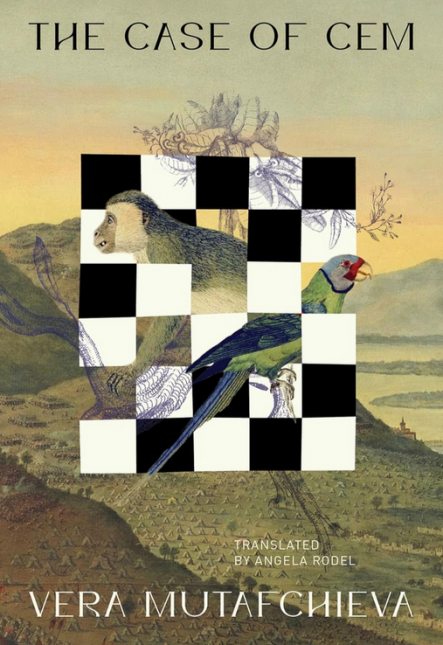The Case of Cem
- By Vera Mutafchieva; translated by Angela Rodel
- Sandorf Passage
- 570 pp.
- Reviewed by Marilyn Oser
- January 22, 2024
An ambitious if flat account of a long-ago, would-be sultan.

The 15th century. In Europe, it was the time of the Borgias, the Medicis, Savanarola, Machiavelli, victory over the Moors in the reconquest of Spain, and the first three of Columbus’ four voyages to the New World. In Asia, the 1400s were a time of enlargement and burgeoning strength for the still-young Ottoman Empire. Emerging from the East toward that century’s end, Cem Sultan became a name to conjure with, a name that dominated Eastern and Western conflicts and standoffs. Cem was lionized in poetry and song and remained so into the 17th century. Today, though, his legend is generally unknown, his history and fate unheralded.
Enter Vera Mutafchieva (1929-2009), a Bulgarian historian who specialized in the Ottoman period. In the mid-1960s, she set out to portray “the truth about the Case of Cem” in a novel that describes this would-be sultan’s life as a pawn of naked East/West (read Muslim/Christian) political maneuverings. The Case of Cem has now been translated into English by Angela Rodel.
The tale begins in 1481, when the untimely death of Sultan Mehmed “the Conqueror” sets off a crisis. Without a designated heir, Mehmed is to be succeeded by his eldest son, Bayezid. Tradition dictates that Bayezid’s younger brother, Cem, be put to death. But Cem, his father’s favorite — and well-liked among the Ottoman troops — readily takes action when urged to oppose the rule of his unappealing brother. His early successes in doing so prompt Cem to propose shared leadership by splitting the empire in two. Bayezid refuses.
Soon, a disastrous defeat forces Cem to flee to the Greek island of Rhodes, where he finds refuge with its Christian order of knights. Through a mind-bending trail of double-crosses — among them Bayezid’s proffer of bountiful annual support for Cem’s “care” — Cem finds himself instead a hostage in Rhodes, a hapless exile fated to endure ever-narrowing imprisonment.
In the game of European politics, Cem becomes the necessary pawn all the powers vie for. Over a period of 13 years, he is shuffled from Greece to sites in France and, finally, to Rome, as various powers — among them Hungary, Germany, Venice, and even Egypt — strive to secure him. He is seen as the key to slowing Ottoman expansion westward, not to mention gilding the treasury and reputation of whoever acquires him.
The novel is structured as a series of testimonies given before a court by figures involved in Cem’s life. Long dead, these witnesses have appeared from some sort of great beyond to reveal individual portions of the narrative which proceed in chronological order. The reader isn’t immediately told when this hearing takes place, nor where, why, or by whom it is convened.
While the setting within each of the testimonies is plain, it’s not until a third of the way into the book that a witness says, “Five centuries have passed,” thus placing the hearing in roughly the present day. (At least, the author’s present day.) If, as it seems, this is the “court of history,” then presumably we readers are the judges — but to what end remains unclear.
It’s possible Mutafchieva had an historian’s ax to grind — an interpretation to champion with no hard evidence to support it. Thus, the novel may serve as her version of history thinly disguised as fiction. Yet her translator reports in an introductory note that the author altered some names and historical details, and that some of the testimonies are unreliable “if not downright deceptive.” Remarks one of the characters:
“When you try to explain history, leave a small but essential part of it unexplained. It is inexplicable, resign yourself to this.”
Inexplicable though history may be, this story of a man who in real life was treated like an object cries out for authenticity, especially given the author’s claim in her foreword to truth-telling. One would expect the testimonies — offered as they are by characters with divergent backgrounds, experiences, and aims — to be rendered in sharply varied voices. Yet with few exceptions, a dull sameness dominates, one characterless and lacking in wit or color. Images are rare, and when they do appear, are often quite strange (e.g., “his horse carried me off like a blizzard”).
A commonplace of the storyteller’s craft dictates that a novelist must show and not tell. In my own writing, I’ve generally scorned this rule, holding that any identification of the borderline between “showing” and “telling” exposes the critic’s prejudices rather than the author’s shortcomings. Either my supposition is unsound, or The Case of Cem is the exception that proves the rule, for this book is way too full of telling. It would be much improved by more explicit detail, livelier dialogue, and fewer summaries of major events that beg to be dramatized.
Cem’s story has the elements of a great saga: armed clashes, a heartrending love interest, skirmishing between two cultures, and (as suits modern tastes) interior struggles involving exile, loss, and loneliness. Fine scenes and passages there are — like literary sparks hinting at what might’ve been. One poignant remark describes the East’s love of beauty in the face of an immensity of evil:
“Such love hinders you from fathoming the world to its depths, but instead helps you bear it.”
The Case of Cem could have helped us bear today’s depths had its sparks only come with sufficient frequency, fullness, and force to ignite a fire in readers.
Marilyn Oser is the author of the novels This Storied Land, November to July, Even You, and Rivka’s War; the blog “Streets of Israel”; and other short fiction and nonfiction. A recipient of the University of Michigan’s Hopwood Prize, she has been called “a particularly gifted novelist” by the Midwest Review.

